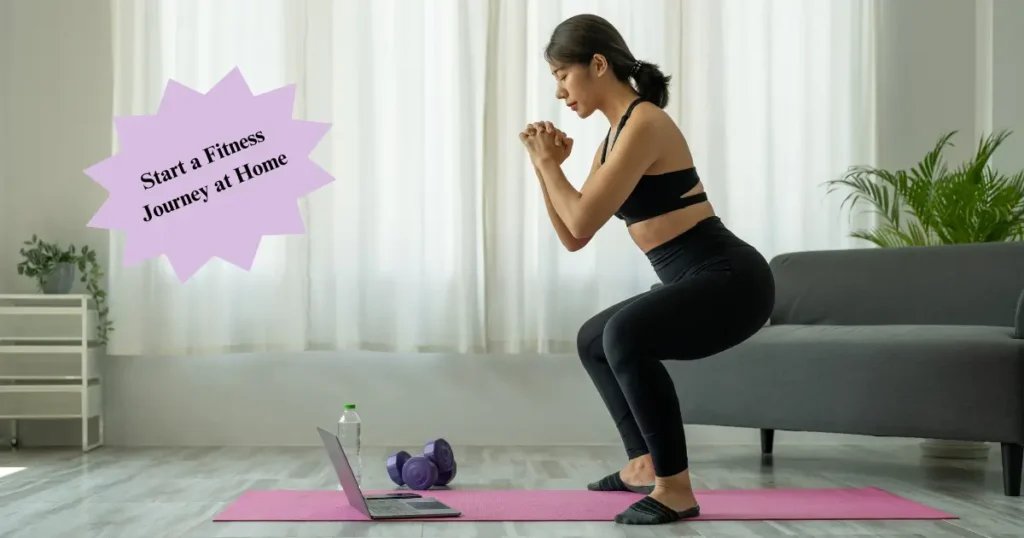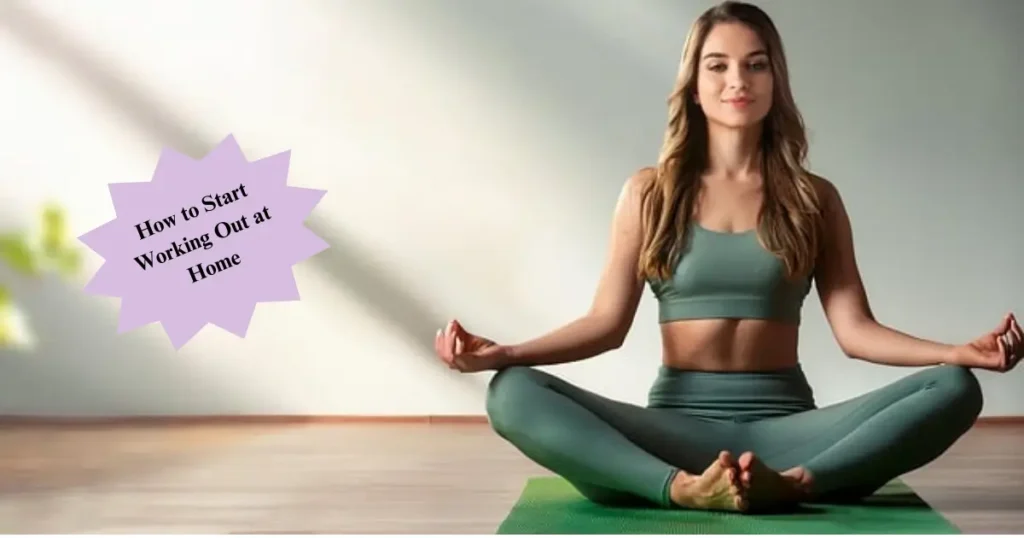Starting your fitness journey can feel overwhelming, especially if you are unsure where to begin. The good news? You don’t need a gym membership or expensive gear. How to Start a Fitness Journey at Home for Beginners is more than a topic—it’s a lifestyle shift that begins with you, right where you are. Whether you want to lose weight, build strength, boost energy, or improve your mental well-being, working out at home is a smart, affordable, and sustainable option. This beginner-friendly guide will walk you through simple steps, helpful strategies, and key mindset shifts to build a strong foundation for long-term fitness success.

Why Start a Fitness Journey at Home?
Before you jump into exercises and routines, it’s essential to understand the why. Starting at home gives you:
- Convenience – No travel time or strict schedules.
- Affordability – Skip the gym fees and use everyday household items.
- Privacy – No fear of judgment from others.
- Consistency – You’re more likely to stick with it when it’s easy to access.
Your home can become a powerful training space if you learn how to use it well.
How to Start a Fitness Journey at Home for Beginners
This section dives into the actual steps and structure of creating a beginner-friendly fitness lifestyle right at home. Whether you are motivated by weight loss, mental clarity, or building strength, this step-by-step approach lays the foundation for real progress.
Step 1: Clarify Your Purpose and Set Specific Goals
Every successful fitness journey starts with a strong sense of purpose. Without a clear “why,” it’s easy to lose motivation when life gets busy or results take time. So, before jumping into workouts, take a moment to ask yourself:
- Why do I want to get fit?
- What do I hope to achieve in 3 months? 6 months? A year?
Your reasons might include losing weight, increasing energy, gaining confidence, managing stress, building muscle, or simply feeling stronger and healthier. There’s no wrong answer—what matters is that it’s meaningful to you. Once you identify your “why,” write it down and place it somewhere visible. This daily reminder can be your anchor on the tough days.
Next, turn your why into realistic goals using the SMART goal-setting method:
✅ Specific:
- Define exactly what you want to achieve.
- Example: “I’m committed to walking 10,000 steps every day.”
✅ Measurable:
- Track your progress with tools like a fitness tracker or your smartphone.
- “I will monitor my daily steps using my phone app.”
✅ Achievable:
- Start small and build gradually.
- “I’ll begin with 5,000 steps and increase weekly.”
✅ Realistic:
- Make sure your goal fits your lifestyle.
- “Even on busy days, I’ll schedule time for movement.”
✅ Time-bound:
- Set a deadline to stay focused.
- “I’ll reach this goal within 30 days.”
Clear goals create direction, accountability, and a reason to keep going—even when motivation fades.
Step 2: Prepare Your Space for Success
Creating a dedicated workout area at home sets the tone for consistency and commitment. The great news? You don’t need a huge space or expensive equipment to get started. Just a small, clean corner in your living room, bedroom, or even a hallway can become your personal fitness zone. The key is to make it a space where you want to move.
Here’s what you will need to set up your home workout area:
✅ Essentials:
- Yoga mat or rug – Perfect for floor exercises, stretching, and core work.
- Water bottle – Staying hydrated keeps your energy up.
- Towel – Keep sweat in check and stay comfortable.
- Mirror (optional) – Great for checking your form and posture.
- Good lighting and ventilation – Bright, fresh spaces are more inviting and energizing.
If you are ready to invest a little more into your setup, consider these additions:
- Resistance bands – Affordable, versatile, and perfect for strength training.
- A pair of dumbbells – Start with light to medium weight; adjustable ones offer long-term value.
- Jump rope – A fun, effective way to boost cardio at home.
- Stability ball – Ideal for core workouts and improving balance.
Your workout space doesn’t have to be perfect—it just needs to be yours. When your environment is ready, it becomes easier to stay motivated and show up for yourself daily.
Step 3: Choose Your Workout Style
One of the best things about starting your fitness journey at home is the freedom to choose what works for you. There’s no one-size-fits-all approach—your workout should match your goals, lifestyle, and most importantly, your interests. When you enjoy what you’re doing, staying consistent becomes much easier.
Here are some popular and beginner friendly at home workout styles to explore:
- Bodyweight training – Simple yet effective exercises like push-ups, squats, lunges, and planks that require no equipment but build strength and endurance.
- Yoga or Pilates – Great for flexibility, balance, core strength, and stress relief. Perfect for beginners looking for a low-impact start.
- Dance workouts – Zumba, hip-hop cardio, or follow-along dance videos make exercising fun and energizing while burning calories.
- HIIT (High-Intensity Interval Training) – Short, powerful bursts of movement followed by rest. Ideal for fat-burning and improving stamina in less time.
- Walking indoors or on a treadmill – Simple, low-impact, and effective for heart health and weight loss.
- YouTube fitness videos or mobile apps – Thousands of free or low-cost guided workouts tailored for beginners. You can choose by duration, intensity, and style.
The golden rule? Do what you enjoy. If you dread your workout, it’ll be hard to stay motivated. Try different styles until you find one—or a mix—that makes you feel good and excited to keep going.
Step 4: Start with a Beginner Home Workout Plan
Having a simple, structured plan takes the guesswork out of your day and keeps your motivation high. Instead of wondering what to do next, you’ll know exactly what’s on your schedule. This consistency is key to building lasting fitness habits.
Here’s a sample 7-day beginner home workout plan to help you get started:
Day 1 – Full Body Stretch + 15-Min Walk
- Ease into movement and wake up your muscles with gentle stretches and light cardio.
Day 2 – Bodyweight Strength
- Do 2 rounds of squats, lunges, push-ups, and glute bridges to build foundational strength.
Day 3 – Yoga for Beginners
- Follow a 30-minute YouTube yoga session to improve flexibility and reduce stress.
Day 4 – Rest Day
- Let your body recover. Optional: Take a gentle walk or do light stretching.
Day 5 – Cardio Blast
- March in place, do jumping jacks, and high knees for 20 minutes to get your heart rate up.
Day 6 – Core Focus
- Strengthen your abs and lower back with 2 rounds of planks, crunches, and leg raises.
Day 7 – Dance Workout or Walking Challenge
- Choose a fun dance video or aim for a step goal to keep things exciting and lighthearted.
As your body adapts, feel free to increase the intensity or add more rounds. You can repeat this plan weekly or customize it to match your evolving goals and preferences. The key is progress—not perfection.
Step 5: Schedule Your Workouts Like Appointments
When it comes to building a lasting fitness habit, consistency beats intensity every time. That means showing up regularly matters more than doing long or hard workouts occasionally. One of the best ways to stay consistent is by treating your workouts like important appointments—non-negotiable, scheduled, and part of your daily routine.
Pick a time that works best for your lifestyle—whether it’s in the morning to kickstart your day, during lunch for an energy boost, or in the evening to unwind. The key is to be consistent with your timing so it becomes second nature.
Here are some helpful tools to keep you on track:
- Phone reminders – Set alarms or calendar events to prompt your workout time.
- Workout journals – Write down your daily activity to track progress and stay accountable.
- Habit tracker apps – Use apps like Habitica, Streaks, or Loop Habit Tracker to stay motivated and celebrate consistency.
Remember, even just 20 minutes a day can lead to real, long-term change. It’s not about being perfect—it’s about showing up for yourself regularly. Once your workouts become a habit, they’ll feel less like a chore and more like a part of your lifestyle.
Step 6: Focus on Nutrition and Hydration
Exercise is only one piece of the puzzle— what you eat and drink plays a huge role in your fitness progress. You can’t out-exercise a poor diet, so developing healthy eating habits alongside your workouts is essential for real, lasting results.
Fueling your body with the right nutrients gives you energy, supports muscle recovery, and helps you reach your goals faster. The good news? You don’t have to stick to a rigid diet. Just start with small, sustainable changes.
Here are a few easy tips to help you begin:
- Drink at least 8 glasses of water daily – Staying hydrated improves energy, metabolism, and workout performance.
- Eat more whole foods – Fill your plate with colorful fruits, vegetables, lean proteins (like chicken, fish, tofu), and whole grains.
- Limit processed foods and sugar – Cut back on packaged snacks, sugary drinks, and takeout meals that add empty calories.
- Don’t skip meals – Especially breakfast! Skipping meals may cause energy slumps and lead to overeating later in the day.
- Keep healthy snacks on hand – Nuts, yogurt, hard-boiled eggs, or fruit are great options for quick, nutritious bites.
- Try meal prepping once a week – Cooking in batches saves time, reduces stress, and keeps you on track with healthy choices.
Nutrition doesn’t have to be complicated. Focus on progress, not perfection—and remember that small, consistent choices lead to big changes over time.
Step 7: Track Your Progress and Celebrate Wins
Tracking your progress is a powerful way to stay motivated and see how far you have come—even when the scale doesn’t move. It reminds you that your hard work is paying off and helps you stay focused on your goals. Progress isn’t just about weight loss—it’s about strength, energy, consistency, and confidence.
Here are a few easy and effective ways to measure your progress:
- Photos – Take front, side, and back pictures once a month in the same outfit and lighting. Visual changes are often more noticeable than numbers.
- Measurements – Track inches around your waist, arms, hips, and thighs. It’s a great way to see physical changes beyond the scale.
- Weight – If you choose to track weight, do it weekly or bi-weekly—don’t obsess. Your body fluctuates naturally.
- Fitness milestones – Celebrate improvements like doing more push-ups, holding a plank longer, walking more steps, or feeling less tired after a workout.
And don’t forget to celebrate every win, no matter how small. Whether it’s “I worked out 5 days in a row!” or “I managed to hold a plank for a full minute!”—each step forward matters. Reward yourself with non-food treats like new workout gear, a relaxing bath, or a feel-good playlist. These little celebrations keep your journey fun and fulfilling.
Progress is personal—track what motivates you and let those victories fuel your next steps.
How to Start Working Out at Home Without Feeling Overwhelmed

Feeling unsure or intimidated when starting something new—especially fitness—is completely normal. The key is to start small and build slowly. You don’t need to jump into hour-long workouts or complicated routines. Begin with something simple, like a 10-minute walk, gentle stretches, or a beginner YouTube video. The goal is just to move and create a habit.
Here are a few practical tips to stay motivated and make working out feel easier and more enjoyable:
- Lay out your workout clothes the night before – This simple act signals your brain that movement is part of the plan.
- Follow fitness influencers or YouTube trainers – Choose people whose style and energy inspire you. It makes workouts feel more personal and fun.
- Join online challenges or fitness groups – Being part of a community gives you support, encouragement, and a sense of accountability.
- Reward yourself – Celebrate your efforts with non-food treats like new workout gear, a fun movie night, or something that makes you smile.
Most importantly, remember this golden rule: progress beats perfection. You don’t need to be perfect—just stay consistent and keep moving forward. Every small step counts, and over time, they add up to big change.
Easy Home Workouts for Beginners That Actually Work
You don’t need a gym membership or fancy equipment to start getting fit. These beginner-friendly home workouts are designed to be simple, effective, and easy to stick with. Whether you have 10 or 30 minutes, these routines can help you build strength, boost endurance, and burn calories—all from the comfort of your home.
1. Beginner Cardio (No Equipment)
Great for getting your heart rate up and improving stamina.
- 30 seconds jumping jacks
- 30 seconds high knees
- 30 seconds butt kicks
- 30 seconds rest
✅ Repeat 3–4 rounds
2. Total Body Strength (Bodyweight)
Builds full-body strength using only your body weight.
- 10 squats
- 10 push-ups (modify on knees or do wall push-ups)
- 10 lunges (each leg)
- 20-second plank
✅ Repeat 2–3 rounds
3. Core Burn (Low Impact)
Focuses on strengthening your abs and improving core stability.
- 15 crunches
- 10 leg raises
- 30-second plank
- 20 bicycle crunches
✅ 2 rounds is a great start!
These workouts are quick, effective, and totally beginner-friendly. You can adjust the rounds or rest time based on your fitness level. The best part? You can do them anytime, anywhere. Just press play on your favorite music or video and get moving.
Overcoming Obstacles in Your Home Fitness Journey
No matter how motivated you are at the beginning, challenges will pop up. The good news? With a little strategy, you can overcome them and keep moving forward. Here’s how to handle some of the most common roadblocks:
Problem: Lack of motivation
Solution: Set small, achievable goals. Follow creators who inspire you. Change up your routine weekly to keep it fresh and exciting.
Problem: Distractions at home
Solution: Create a workout “bubble.” Mute your phone, shut the door, and play music that pumps you up. Treat your workout time as sacred.
Problem: No time
Solution: Break your workouts into chunks—10 minutes in the morning, 10 in the evening. It all adds up and keeps the habit alive.
Problem: Don’t know what to do
Solution: Use free resources like beginner workout plans on YouTube or Pinterest. Bookmark your favorites so they are easy to access when you need them.
How to Stay Consistent in the Long Run
Long-term success doesn’t come from doing everything perfectly—it comes from showing up consistently and adapting along the way. Here’s how to make fitness stick:
- Think long-term – Focus on building habits, not chasing quick fixes.
- Make fitness part of your lifestyle – Not a temporary task or punishment.
- Don’t beat yourself up – Missed a day? It’s okay. Get back on track the next.
- Keep learning – Listen to fitness podcasts or read health blogs to stay inspired.
- Involve a friend or accountability partner – Support makes a huge difference.
- Keep it fun – Try new workouts, music, or themes to stay engaged.
Your journey is uniquely yours—make it enjoyable, flexible, and full of growth.
Starting a Fitness Routine at Home Can Change Your Life
Taking control of your health isn’t just about physical change—it’s about transforming your whole life. When you start moving your body regularly, everything shifts: your mindset becomes clearer, your energy increases, and your confidence grows stronger. Home workouts aren’t just convenient—they build discipline, self-love, and consistency that spill into every part of your life.
You are not just sculpting a stronger body—you’re creating a better version of yourself.
So don’t wait for the “perfect” time. Not Monday. Not next month. Not New Year’s Day. Start now—right where you are, with what you have—and let yourself grow from there.
Conclusion: How to Start a Fitness Journey at Home for Beginners
Now you have got the tools and guidance to start your fitness journey at home—and it’s truly simpler than it seems. You don’t need fancy equipment or a strict routine. What you do need is commitment, consistency, and a plan that works for you. Take it one step at a time. Small actions done daily lead to lasting transformation. Progress is built by showing up, even on the days when motivation is low.
So unroll your mat, lace up your sneakers, press play on that video—or just step outside for a walk. Every move counts. You have got this—and your future self will thank you for starting today.











